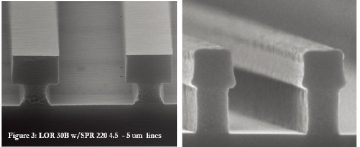Process Name:
Lift-off process using a bilayer LOR/PMGI and Any Resist
Author:
Dr. Nabil Shalabi
Overview:
LOR and PMGI resists are based on polydimethylglutarimide. Its unique properties enable LOR and PMGI products to perform exceptionally well when used, either as a sacrificial layer, or as an undercut layer in bi-layer lift-off processing. LOR and PMGI resists are designed for applications requiring high resolution imaging, easy process tuning, high yields and superior deposition line width control (lift-off).

An overview of the process is described in detail on the microchem page. It is important to review this link and the process involved to fully understand how to use LOR.
https://kayakuam.com/wp-content/uploads/2019/10/RevPMGI-Resists-data-sheetV-rhcedit-100311.pdf
Procedure for a lift-off process:
Wafer cleaning (optional)
- Room temperature clean
- Acetone followed by IPA and DI water (at room temperature)
- Acetone is highly flammable and should not be heated for safety reasons
- Blow dry with nitrogen
- Acetone followed by IPA and DI water (at room temperature)
- High temperature clean
- 80 C 1165 remover followed by DI water until 1165 residue is gone
- 1165, PG remover, and NMP are all the same chemical
- To note, it is possible to use 1165 at room temperature as well or any temperature below 80C
- Blow dry with nitrogen
- 80 C 1165 remover followed by DI water until 1165 residue is gone
- Dehydration
- Optional step: perform a dehydration bake, either on a hotplate or in the small cleanroom oven – 10 -15 min at 150C)
LOR coating
- LOR does not normally need an adhesion layer; it can be spun directly if used as described in the data sheet online.
- For example, spin LOR2A at 4000 rpm, 1000 rpm/s, 45s would result in a 140 – 150 nm thick layer of LOR2A
- The thickness of the LOR should be at least 25% more than the thickness of the metal that needs to be deposited.
LOR bake
The soft bake dramatically affects the undercut that will be experienced with LOR. The higher the temperature the lower the rate of undercut
- For example, LOR2A can be baked at 200 C for 5 min and that would result in an undercut rate of approximately 0.8 µm/min in normal TMAH based developer (Ex. MIF 300)
Resist coating
Coat the wafer with any resist and process that as normal for that resist. That means, spin, soft bake, expose, post exposure bake if needed for the used resist.
Develop
- If the resist develops with TMAH based resist then just develop the resist as normal and that will automatically undercut the LOR layer under the resist.
- Increasing the develop time beyond the full development of the resist will result in more undercut.
- It is possible to develop and inspect and then develop more if needed
- To see the undercut in the microscope, it is possible to use Bright field or Dark field imaging if the undercut is not clear
- If the resist is not TMAH based developable (like SU8) then you must first develop the resist then use a TMAH developer after that to clear out the LOR and undercut the LOR under the resist
Rinse and Dry
Rinsing with water and drying with nitrogen gun is good to start. If the undercut is too deep and the features are small, then you can let it air dry vertically to avoid any damage from the nitrogen gun.
Stripping
To strip the resist for lift-off or if wanting to repeat the process then use 1165 at room temperature or at a temperature below 80 C to remove the LOR and the resist. If using SU8, this might be more challenging as SU8 is hard to remove, but it might be possible to use the LOR to lift-off the SU8 with 1165 chemical.